If you are into interior decoration as a hobby or are a professional, you might be aware of statement plants. Characterized by their unique complexion, structure, size, or texture these plants elevate the look and feel of any interior space with their foliage. According to this study (Pérez-Urrestarazu et al., 2021) the majority of its participants agreed that vegetation in indoor living spaces positively influenced their emotional well-being during the confinement period. The fiddle leaf fig is one of the latest entries among this group of flora. Daniel Kanter, who writes the blog Manhattan Nest, states in this article by The New York Times, that it is essentially a photogenic plant. He further mentions how it appears on the internet more than in reality. That, of course, can be justified by the transformative appeal it brings to any social media users’ palette.

The Fiddle Leaf Fig (Ficus lyrata) belongs to the Moraceae family of plants. Renowned for its coarse dull leaves which bear a striking resemblance to violins (hence fiddle-shaped), they have been creating quite the uproar. Despite their cultural appeal, these evergreen plants are quite fragile and require intensive care. If you have grown tired of cleaning up branches and leaves, fret not as I will instruct you on how to save a fiddle leaf fig.
Also read: How to Grow Morel Mushrooms? | Complete Guide
How to Save a Fiddle Leaf Fig? (Guide)
Given the considerable amount of investment you might have made on these houseplants, you’ll be looking for longevity. On the contrary, the fiddle leaf fig is pretty susceptible to a bunch of complications. So let us go over some of the basics of indoor gardening and lessen your burden on how to save a fiddle leaf fig. These should help you address a considerable amount of problems you might be having while nurturing your fiddle leaf fig plant.
Placement
Placement is key for any plant and a quintessential factor in gardening. Location plays a major role in providing nourishment and the proper conditions for growth. For this plant, ensure that you have not placed it anywhere near drafts as they hate these spots and will suffer immensely. Once the cool spots are out of bounds, check for a spot with plenty (and I mean as much as possible) of indirect light. Place them near this spot and ensure that your fiddle leaf fig is not shifted around the place. Water them weekly and rotate the plant marginally while doing so. Facilitating the same will allow the leaves to receive equal sunlight and prevent them from growing towards the light source.

Leaf Cleaning
Every nuance counts when you are looking at how to save a fiddle leaf fig; even if it sounds as trivial as wiping leaves clean. Accumulated dust may lead to cobwebs from spider mite infestations as well as aphids and squash bugs that destroy leaves. Use a slightly damp tablecloth and gently wipe off the dust from the leaves now and then (monthly at least). Refrain from applying any external form of oil to improve cleaning as it will only clog the leaf’s stomata and suffocate it.
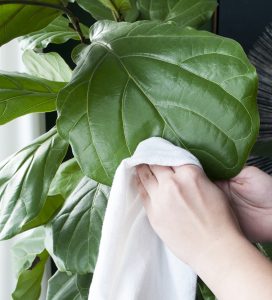
Check Atmospheric Moisture
Fiddle leaf figs are native to the humid, tropical rainforests of West Africa. Since most households contain an average of more than 35% air humidity, it should be fine. However, in case you feel that the environment is too dry, you can try misting your plant weekly.
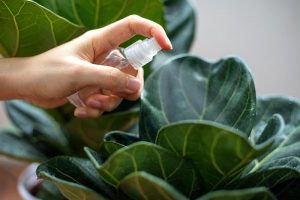
Watering the Plant
Water acts as the primary nutrient facilitator in plants and can easily be a make-or-break factor. You must water your fiddle leaf fig once a week or every 10 days. As I mentioned earlier, they are native to African forests and hence, are used to flash floods with spells of dryness in between. To fabricate the same environment make sure you submerge the plant and then leave it to dry till the next watering interval. Your best bet would be to get a drip tray so that the roots are not exposed to water over a prolonged period.
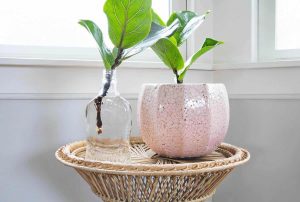
Using Fertilizers
According to multiple sources, fiddle leaf fig plants prefer fertilizers with a Nitrogen-Phosphorus-Potassium (NPK in short) ratio of 3:1:2. Although it might sound too technical for your liking, these fertilizers can be easily found. Once you have acquired them, use them by mixing them into your watering can as per the instructions on the package.
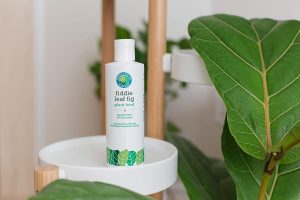
Pruning and Shaping
If you remember one of the earlier issues we discussed in this guide on how to save a fiddle leaf fig, you’ll recall problems with the branches and leaves. Given the growth tendencies of these plants, they tend to have tall trunks and broad leaves. As a result, these plants require what I call a “Bonsai treatment” (pruning) to turn them into domestic, household friendly versions of themselves. Keep in mind that patience is the utmost virtue when it comes to gardening and these guys need to be given at least 18 months to grow into your favoured specifications.
Pruning and shaping is primarily done to get rid of dead mass and replenish the plant since browning leaves might dry out the plant eventually. Use a proper set of clean pruning shears and trim the stem of the affected leaves in an angular manner. Make sure you have kept a gap of at least half an inch from the trunk to avoid any form of damage. Try not to exceed trimming 7 to 8 leaves at a time lest the plant goes into shock. You can also try radical pinching by severing the upper half of the plant when it gets too tall. Pinching and snapping off a bud from the top of the plant till sap starts secreting from the area would also help promote new top growth.
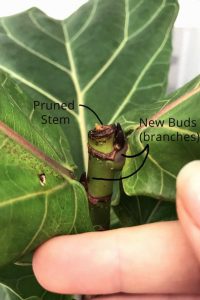
Soil and Repotting
Essentially, repotting is considered at a stage when a plant starts to look too big for the pot or its roots have outgrown the drainage holes. This generally occurs once in a year or two. Once you have decided to go for repotting, select a pot which is 2-3 times larger than the previous one. Now, add a few inches of stones to the bottom of this pot to allow drainage, maintain humidity and also prevent root rot from setting in. For your new base, look for moisture-control soil that has good drainage capabilities. Cover the new pot from edge to edge and leave out a hollow centre. Put your root ball in this crevice after you have trimmed out any browning or rotten root filaments. Add a little more topping soil and level the ground to finish.
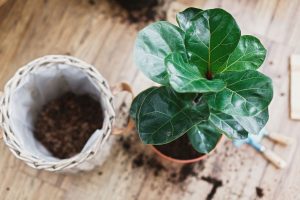
More Problems
Despite following through on the basics, you still might encounter a bunch of problems that threaten your plant. Worry not, as we’ve got you covered on how to save a fiddle leaf fig and give you a complete guide.
- Yellowed leaves – The main problem with yellowed leaves is that it can indicate myriads of issues like excess water, lack of light or fertilizer or even a bacterial infection. Repotting and pruning the affected leaves should help solve this problem.
- Nibbled leafage – If you spot small holes on your fiddle leaf fig, it might be a sign of spider mite, aphid or other bug infestations. Applying neem oil directly to both sides of the leaves should help with pest control.
- Whitened leaves – Excess exposure to sunlight or a mildew infection may cause this problem. While the dusty, white mildew fungus can be disposed of with neem oil, humidifiers and pruning, keeping the plant in shaded areas can help with sunburns. Make sure that the leaves are not variegated as some unique species (called ‘unicorns’) have this rare feature.
Closure
In short, Fiddle leaf fig trees are a costly and troublesome affair. However, if you are really passionate about rearing them, and take appropriate care of them, they can be wonderful additions to your household decor. Should you face problems in doing so, this article on how to save a fiddle leaf fig will definitely be of considerable help. As plants require a certain level of tending to, always ensure that you will be able to meet their basic requirements prior to getting one.
